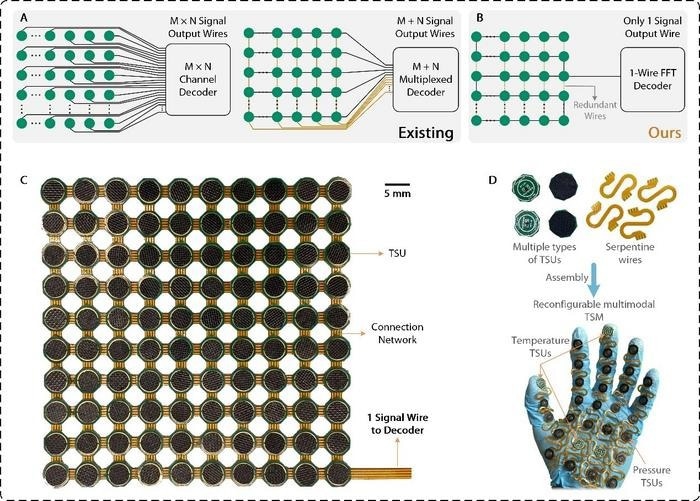Scientists at the Hong Kong University of Science and Technology (HKUST) have created a technology for sensor arrays that draws inspiration from the human auditory system.
 Comparison of sensor array schemes, fabricated 10 × 10 nonstretchable pressure sensor array and multimodal pressure-temperature sensor array prototypes. Image Credit: Hong Kong University of Science and Technology
Comparison of sensor array schemes, fabricated 10 × 10 nonstretchable pressure sensor array and multimodal pressure-temperature sensor array prototypes. Image Credit: Hong Kong University of Science and Technology
This novel sensor array design, influenced by how the human ear can differentiate between sounds using tonotopy, can potentially enhance the use of sensor arrays in various sectors, including robotics, aviation, healthcare, and industrial machinery.
Conventional sensor arrays encounter issues such as intricate wiring, restricted reconfigurability, and susceptibility to damage. The HKUST team, spearheaded by Associate Professor Zhengbao Yang from the Department of Mechanical & Aerospace Engineering, has devised a solution to these challenges.
Their design allocates a distinctive frequency to each sensor unit, employing the sensor unit signal to modulate the amplitude of the frequency signal. This method mirrors the processing of distinct frequencies by hair cells in the human cochlea.
Subsequently, these amplitude-modulated signals with varied frequencies are overlaid onto a solitary conductor, and a Fast Fourier Transform algorithm is employed to interpret the distinct signals.
This design efficiently minimizes the extensive output wires present in the traditional row-column arrangement to a singular wire, preserving functionality. This inventive approach enables the decoding system to process information from all sensor units simultaneously, presenting a notable departure from the current practice of time-division multiplexing in sensor array decoding.
The research team employs a redundancy design in the sensor connection network to guarantee uninterrupted operation, even in the presence of damage to portions of the array's connection network.
Drawing inspiration from the numerous synaptic connections between hair cells in the inner ear and neurons, this design incorporates a backup mechanism in case one pathway becomes compromised.
This redundant configuration not only improves the system's resilience to damage but also enhances reconfigurability, a crucial attribute in dynamic settings like responsive robotics or adaptable wearable devices. The Lego-style modular design may also result in cost savings for maintenance, as it proves more accessible to repair than traditional multi-wire sensor arrays.
The suggested sensor array technology presents numerous potential applications due to its adaptability and durability. Its capability to integrate seamlessly into curved surfaces and function in challenging environments makes it highly versatile.
The sensor array can conform to the shape and fulfill the multimodal sensing needs of the surface, offering real-time data. In practical terms, the team has showcased the functionality of the sensor array in two key applications—a pressure sensor array and a pressure-temperature multimodal sensor array.
The latter, especially noteworthy for its ability to monitor crucial parameters in medical prosthetics, holds promise for improving user comfort and safety. Additionally, the team highlights the technology's potential in monitoring strain distribution in airplane wings, a prospect that could significantly contribute to the advancement of safer and more fuel-efficient aircraft.
Despite its numerous advantages, the sensor array design does face certain limitations. The operational bandwidth of the circuits restricts the number of sensor units in the array, and the potential for miniaturization is constrained by the size of off-the-shelf electronic components needed for each sensor unit.
Moving forward, the HKUST team aims to streamline the sensor array's design further and explore commercial partnerships to facilitate the technology's entry into the market.
Journal Reference:
Long, Z., et al. (2023). One-wire reconfigurable and damage-tolerant sensor matrix inspired by the auditory tonotopy. Science Advances. doi.org/10.1126/sciadv.adi6633.